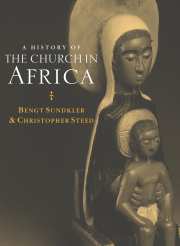Book contents
- Frontmatter
- Contents
- List of maps
- Acknowledgements
- List of abbreviations
- Introduction
- PART I THE FIRST FOURTEEN HUNDRED YEARS
- PART II THE MIDDLE AGES 1415 – 1787
- PART III THE LONG NINETEENTH CENTURY 1787 – 1919
- 3 Overview To The Nineteenth Century
- 4 North and North-Eastern Africa
- 5 Western Africa
- 6 West-Central Africa
- 7 Southern Africa
- 8 South-Central Africa and the Indian Ocean
- 9 East Africa
- 10 East-Central Africa
- PART IV THE COLONIAL EXPERIENCE 1920 – 1959
- PART V INDEPENDENT AFRICA 1960 – 92
- Notes
- Bibliography
- Name index
- Subject index
8 - South-Central Africa and the Indian Ocean
from PART III - THE LONG NINETEENTH CENTURY 1787 – 1919
Published online by Cambridge University Press: 16 September 2009
- Frontmatter
- Contents
- List of maps
- Acknowledgements
- List of abbreviations
- Introduction
- PART I THE FIRST FOURTEEN HUNDRED YEARS
- PART II THE MIDDLE AGES 1415 – 1787
- PART III THE LONG NINETEENTH CENTURY 1787 – 1919
- 3 Overview To The Nineteenth Century
- 4 North and North-Eastern Africa
- 5 Western Africa
- 6 West-Central Africa
- 7 Southern Africa
- 8 South-Central Africa and the Indian Ocean
- 9 East Africa
- 10 East-Central Africa
- PART IV THE COLONIAL EXPERIENCE 1920 – 1959
- PART V INDEPENDENT AFRICA 1960 – 92
- Notes
- Bibliography
- Name index
- Subject index
Summary
THE WAY NORTH TO ZIMBABWE
The way north into Zimbabwe
The nineteenth-century history of South Africa is characterized by a series of north-bound movements. Economic, political and ethnic factors all played a part in these ‘treks’. Going from the south toward the ‘Interior of Africa’, they were also involved with missionary expansion to the Transvaal, to Limpopo and beyond. Even the waggon track from Kuruman, via Shoshong, to Bulawayo and Zimbabwe was called ‘the Missionaries’ Road’. The name could indeed have been ‘The Scottish Missionaries Road’, for it was largely thanks to the remarkable combination of three Scots – Robert Moffat, David Livingstone and John MacKenzie – that the ‘road’ was planned and maintained. Moffat made his four visits to Mzilikazi along that road, culminating in his journey of 1858 to the court at Bulawayo. On that last
visit, the chief gave the LMS land for a station at Inyati, north of Bulawayo. In 1872 another transfer of land resulted in a second LMS station at Hope Fountain. The Missionaries' Road was the official approach to the north for White hunters, explorers, tradesmen and missionaries. Mzilikazi and his successor, Lobengula, expected any foreigners penetrating into their northern country to enter exclusively by that route. The chief could thus rest assured that he controlled any traffic into or out of his land. But there were other roads to the north.
- Type
- Chapter
- Information
- A History of the Church in Africa , pp. 445 - 509Publisher: Cambridge University PressPrint publication year: 2000



